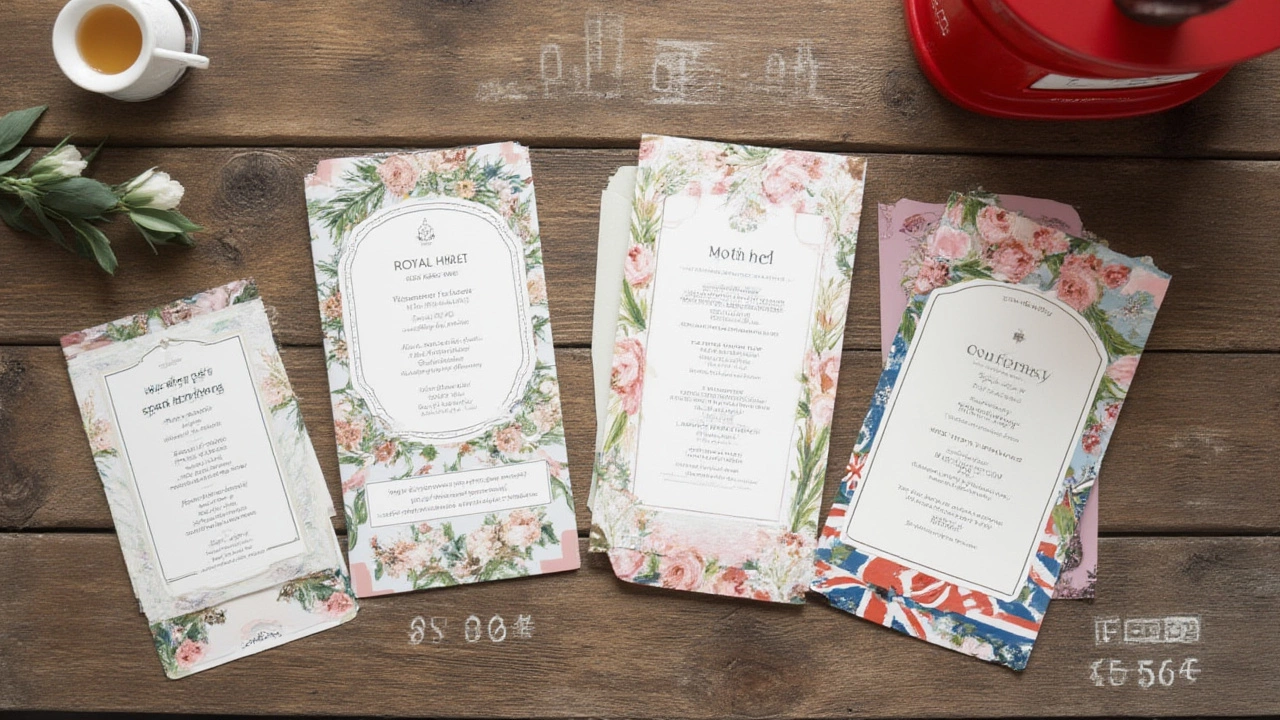Sticker shock hits hard when you get your first wedding invitation quote. Most couples know the dress and dinner aren’t cheap, but $10-$20 per invite? Yep, that’s a reality for many in the U.S. It’s not just about paper—you’re actually paying for art, print quality, and that satisfying envelope fanning moment. And the craziest part? There’s almost no limit to what you can spend if you don’t set some boundaries.
What’s the Real Average Price for Wedding Invitations?
Let’s get the numbers out of the way. According to The Knot’s 2024 Real Weddings Study, the average couple in the U.S. drops between $400 and $700 on standard wedding invitations for 100 guests. That covers basic to moderately fancy designs—nothing gold-foiled, letterpressed, or Instagram-famous. Want that hand-lettered calligraphy or thick velvet ribbon? Then your costs can easily sprint up to $1,500 or more.
Honestly, the range is pretty wild. Some keep it ultra simple and manage $150 for a digital set—they go for pastel PDF invites and print a handful for grandmas. But there are also folks who invest upwards of $3,000 for custom suites, especially if they’re expecting guests to travel or the invitation is seen as a keepsake. Curious what you’d pay per invite? Here’s what to expect:
| Invitation Type | Typical Price Per Invite (USD) |
|---|---|
| DIY/Digital | $0.50–$2 |
| Standard Print (Online) | $2–$5 |
| Specialty Print (Letterpress, Foil) | $4–$10 |
| Custom Designer | $7–$20+ |
What drives the price? Volume matters, but so do extras like custom artwork, double envelopes, fancy ink, and RSVP cards. Even postage adds up—think oversized or oddly shaped invites that need extra stamps (worth checking USPS’s current rates, as for 2025, a standard stamp is now $0.70, but square envelopes need $0.89 each).
What Affects Wedding Invitation Costs?
It’s not just the card and pretty handwriting. Let’s break it down:
- Design and Complexity: A pre-made template can save hundreds. Custom illustrations, hand-painted edges, or specialty die-cut shapes multiply the cost, often doubling or tripling your total.
- Printing Methods: Digital is cheapest. But as soon as you go to letterpress, foil stamping, or engraving, it’s a different league. Letterpress often starts at $7 per card, partly because of the setup and inks.
- Paper Quality: Lightweight cardstock barely dents the budget. Thick, textured, or handmade paper adds that luxe feel—and can raise the bill by 30-50%.
- Embellishments & Extras: Think wax seals, ribbons, vellum wraps, or envelope liners. Each one stacks up. For example, a wax seal adds around $1 per invite, a velvet belly band $2, and an envelope liner $0.80 each.
- Postage: Not everyone thinks about this at first, but in 2025, postage for a 2-ounce square envelope is $0.89 each. Add RSVP cards with their own stamps and you can add $100-$200 to your invitation costs fast.
- Quantity Ordered: Printing 30 saves money per unit, but ordering more than 100 usually means you get price breaks. Always bulk order with a few extras (for last-minute invites, and keepsakes for you and parents).
- Extras in the Suite: Info cards, maps, rehearsal dinner invites, accommodation details—each element adds printing, design, and assembly costs.
Some couples ask: “Do I need a save-the-date card and a separate wedding invite?” You don’t have to—they’re only traditional, not required. Skipping save-the-dates can cut your average wedding invitation cost by 30% or more if you’re looking to trim the fat. If your guest list is mostly local or your timeline is short, save-the-dates are totally optional.

How to Save Money Without Skimping on Style
Saving on invites isn’t just about going digital (though digital can make a big difference). Hundreds of couples keep things beautiful on a budget every year by getting creative. Here’s how:
- DIY the Design: If you have a decent eye for style, Canva and Etsy both offer templates you can personalize. Platforms like Zola offer free or cheap digital designs as well. Print at home, or use a big-box office chain for affordable, good-enough results.
- Skip the Extras: Envelope liners, wax seals, and custom maps look amazing—but guests won’t miss them if you never include them. Prioritize what actually matters to you.
- Batch Printing: Online printers often offer big price drops at 50, 100, or 250 cards. Print a few more than you need, just in case.
- Digital RSVP: Switch out RSVP cards for a personal wedding website. List your phone number or create a Google Form. It’s simple, easy, and saves on extra postage and printing.
- Avoid Custom Art: If you want beautiful invitations but don’t need a one-of-a-kind illustration of your venue, browse semi-custom options—these are pre-made with room to personalize your names, dates, and colors.
- Group Orders: Some suppliers offer package deals if you order thank-you cards, menus, and programs at the same time as invites. Bundle deals save a lot if you’re buying all your wedding stationery together.
- Proof Everything Digitally First: Mistakes cost money. Always double-check details, spelling, and dates. Print a sample before ordering 150 copies—most reputable printers offer proofs for a small fee or free.
It’s tempting to get swept up in Instagram inspiration, but your invitations’ main job is to share your story and details. Nobody talks about the color of the envelope liner five years later. Besides, your guests really just want to know when to show up and if there’s a meal option for them.
Smart Invitation Planning: Tips for 2025 Couples
If you’ve got a 2025 or 2026 wedding lined up, there’s never been a better time to get practical. Paper prices went up during the supply chain chaos of 2022–2024, and they aren’t showing signs of major drops just yet. Here’s what’s trending—and what’s smart:
- Order Early: Ordering 5-6 months ahead gives you breathing room for proofing, printing, shipping, addressing, stamping, and unplanned hiccups. Rush jobs mean express fees—totally avoidable if you do things early.
- Mix and Match Styles: Maybe you want a high-impact invite, but less-fancy RSVP cards. Or perhaps you splurge on a custom design for immediate family but use budget-friendly prints for everyone else. Nobody says you have to spend the same on every card.
- Eco-Friendly and Digital Options: Sustainability is big for 2025. Plantable paper and recycled-stock invites are trending—beautiful and easier on the conscience (prices are similar to mid-range standard invites). Digital-only invites, once considered risky, are now a common choice for destination weddings or small celebrations.
- Double-Duty Stationery: Save money by combining ceremony programs with menus or thank-you cards with place cards. Less waste, more style.
- Ask for Referrals and Discounts: If you love a friend’s invitations, ask who they used—you might get a referral deal or special discount. Some Etsy designers offer repeat-customer or bundle discounts.
- Don’t Forget About Fees: Check for hidden charges before you lock in a supplier—shipping, rush proofs, file setup fees, and taxes sometimes surprise couples at checkout.
- Negotiate with Designers: Plenty of invitation designers offer three tiers: full custom, semi-custom, and template. Know your budget and ask which fits best. Designers often have back-catalogs of beautiful designs from past clients at a fraction of the full-custom price.
One last tip: weigh your finished invites at the post office before buying all those stamps. A lacy belly band can shove your invitations into the next postage tier—adding $50 to $100 to your budget on the spot.
Planning your wedding invitations is partly about the number crunching, but it’s really an opportunity to show personality, hint at your day’s vibe, and keep everyone excited. As long as you keep your expectations (and FOMO) in check, you’ll end up with invitations you genuinely love—whether you spent $1.50 a card or treated yourself to top-shelf custom suites. It pays to budget, research, proofread, and most of all, stay true to what really matters to you both. If you want your guests to be wowed, sometimes less is more—and creativity almost always beats spending more than you wanted to.

